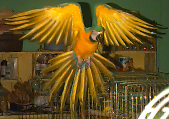Is there more to Bird Flight Than Meets the Eye?
Is There More to Bird Flight than Meets the Eye?
ęCopywrite January 2002
Bill Arbon,
Author

Wings and flight are at the very heart and soul of what is a bird, are they not? Physiology and function clearly indicate that flying birds are dependent on wings for mobility and is necessary for flying birds' daily lives. A more interesting benefit of birds' flying may have a more fundamental reason for bird flight.
For many years scientists puzzled over the avian respiratory system and proposed novel and extremely complicated concepts to explain all the elements of the avian breathing apparatus. In fact, Roger Pasquier writing in his book WATCHING BIRDS-An Introduction to Ornithology, published in 1977 comments about the various sceintific points of view regarding the avian repiratory cycle. I especially remember one long and credible explanation of bird respiration that appeared in Scientific American in the early 70's. The model bird was a duck standing on the ground and the hard-to-follow explanation for air flow and air sac function was a 'had to' read over and over again proposition. Realizing that birds have all these air sacs and pneumatic bones that intercommunicate with each other and are in turn connected to the lungs results in a confused mess to try to understand. Our understanding about the respiration system of a bird at rest is complicated because we know birds don't have large muscular diaphrams to help inflate their lungs. Apparently the air birds breathe passes through their lungs twice which maximizes the gas exchange necessary for prolonged flight.
Still, this explanation worked for me until, thanks to Timmothy Rowe, co-author with Lowell Dingus of The Mistaken Extinction - Dinosaur Evolution and the Origin of Birds. Tim invited me to a talk given by the late Farish Jenkins, a Havard comparative anatomist giving a lecture at the University of Texas. Dr. Jenkins had trained starlings to fly in a wind tunnel and he filmed the birds while flying...with both normal and X-ray cameras! What the developed film revealed is that bird's respiratory systems operate at optimum functioning capacity while a bird is in flight. I watched in amazment as the starlings' bones, muscles, and air sacs worked in unision during each and every up and downstroke of the wings. Most amazing for me was the fact that the sternum rocked back and forth alternately depressing and allowing for expansion of the posterior air sacs. That action assures that the double passing of air through a bird's lungs providing for maximum gas exchange efficiency. Thus the ability - the need - of a bird to fly and the bird's need for maximum pulmonary efficiency for sustained flight are intricately connected. Bones, muscles, lungs and air sacs work togther to produce a complicated, but efficient breathing apparatus.
Many years ago a universtiy study demonstrated that flighted budgies were more successful breeders than non-flying ones. This is not suprising. These revelations mean that flight is not an either or proposition for flying birds, but a necessary, if not an evolutionary (not to speak of revolutionary) one. Farish Jenkin's information has made its way to ornithological texts in one form or another these days and I would expect further developments on the subject in the future. By 1993, Noble Proctor and Patrick Lynch in MANUAL OF ORNITHOLOGY - Avian Structure and Function, basing their comments on Jenkin's work, claim that the furcula (wishbone) acts in birds like a spring that not only aids birds in flight by reducing the work load required by the flight muscles, but also deflates the anterior air sacs resulting in a more complete exchange of respiratory gases. These revalations help explain bird's abilities to fly continuously for long periods of time. One species of shorebird, the Bar Tailed Godwit, migrates non stop across the whole Pacific Ocean between its Alaska breeding ground and its New Zealand winter hunting grounds! What, besides magic, would explain little song birds' breath taking annual globe trotting migrations from northern and southern hemispheres, or the seagoing albatross' ocean spanning flights where they seldom make landfall? No wonder birds are the masters of the sky!
Incidentally, there is another surprising ramification of the form, function and evolution of bird flight. This information has been generated by palenotologists and ornithologists regarding our understanding of the origin of birds - what they are and what animals were their ancestors and the like. The evidence points more and more to the fact - not the possibilty - that birds are dinosaurs. Presently and from now on, I am going to call my birds avian dinosaurs and I am going to advertise the fact that I keep them, breed them and sell them to you for pets!
Return to the Impeckable Aviaries Home page
 E-mail Impeckable Aviaries
E-mail Impeckable Aviaries
IMPECKABLE AVIARIES
PO Box 540 Johnson City, Texas 78636 phone 830-868-4509
Last Updated 09/19/2013

 E-mail Impeckable Aviaries
E-mail Impeckable Aviaries